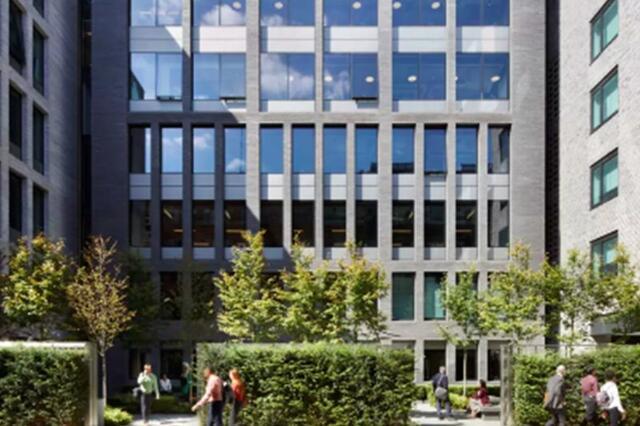Derwent London Achieves Net Zero Success at 80 Charlotte Street
16 February 2024Derwent London Achieves Net Zero Success at 80 Charlotte Street
16 February 202480 Charlotte Street is Derwent London’s first net zero carbon development and one of the largest all-electric schemes in London. It is heated and cooled using air source heat pumps and powered by renewable electricity from certified sources – significantly reducing emissions compared to traditional gas boilers. More than a year after the first occupiers moved in, there have been zero hot and cold complaints, reflecting the huge success of the building’s low carbon heating and cooling systems, combined with high performance fabric.
Key Facts
- Net zero carbon in construction
- Net zero ready in operation
- BREEAM Excellent sustainability rating
- LEED Gold
The Situation
Completed in June 2020, 80 Charlotte Street in London’s Fitzrovia offers around 35,000m2 of office, retail and residential space, including affordable housing, plus a new public ‘pocket park’ inspired by Paley Park in New York. The building was designed by Make Architects, while Arup provided engineering and sustainability services. Arup is also one of the building’s main occupiers, alongside the Boston Consulting Group and Lee & Thompson. Around 100% of the building is occupied, with over 1,000 people regularly using the workspace.
80 Charlotte Street achieved ‘net zero’ carbon in construction (UKGBC Net Zero Carbon Framework definition), reducing embodied emissions as far as possible before offsetting residual emissions at completion. It is also ready for net zero in operation, with all-electric systems that will progressively benefit from grid decarbonisation. Here we explore this milestone in Derwent London’s journey to be net zero carbon by 2030.
Actions
All-electric heating and cooling
Derwent London took the decision to make 80 Charlotte Street all-electric in 2009, when gas was still the go-to fuel for heating. Arup reviewed likely scenarios for the decarbonisation of grid electricity, the unit price of electricity versus gas and the performance of heat pumps. These were all expected to support demand for all-electric buildings.
80 Charlotte Street uses three rooftop air source heat pumps, avoiding fossil fuels and advancing progress to net zero. These supply all the heat and most of the cooling for the building, with additional cooling supplied by two rooftop air-cooled chillers. The building has one of the largest heat pumps in central London, recovering and reusing waste heat via polyvalent units.
Electricity across landlord and occupier areas is purchased from ringfenced renewable sources. 80m2 of rooftop solar thermal panels preheat the domestic hot water. This is then topped up by heat from a dedicated set of air source heat pumps to a temperature of around 65°C. The use of dedicated heat pumps enables the system to run out-of-hours.
Low carbon ventilation
Forward planning in 2009 also highlighted an expectation of growth in electric vehicle use, leading to cleaner air and quieter roads around 80 Charlotte Street, which is an island site. The façades incorporate openable windows. When the windows open, heating and cooling automatically switch off. This mixed-mode ventilation strategy reduces energy demand and gives people greater control over their environment.
The reception and atria are naturally ventilated and, through integrated architecture and engineering, the atria distribute fresh air to office floors, as well as drawing natural light into the heart of the building. Existing cores were relocated and consolidated to create three full-height atria in the right locations for ventilation ductwork. Removing the air ducts from the main floor plates made it possible to retain some of the existing structure’s low floor-to-floor height, while optimising air flow. Fresh-air ducts drop down the atria from rooftop air handling units to supply air to office floors. Fans in the perimeter help draw the air across the floor plates.
Additional features to reduce operational emissions include:
- ‘Glass in the right place’ façades that allow more natural daylight to reach indoors, while minimising solar gain to reduce perimeter cooling demand.
- High air tightness levels of 3m3/h.m2 at 50Pa, improving energy performance.
- BMS operation provided by a Honeywell EBI platform, with OpenBlue Enterprise Manager from Johnson Controls used for performance insights and analytics.
- High efficiency building services and fittings, including an all-LED system for main landlord areas and daylight sensors and controls that automatically dim lighting in response to ambient light levels.
Net zero embodied carbon
Aecom carried out an embodied study at the design stage to identify savings and Multiplex completed an ‘as-built’ embodied carbon assessment. The project team reduced the embodied footprint by over 30% at completion versus the baseline.
Low carbon interventions included:
- Retaining and reusing a significant proportion of the existing buildings, including 15% of the façade.
- Rationalising the new structure to reduce the amount of reinforcement and concrete required.
- Sourcing regional materials with high recycled content, including concrete and steel.
Derwent London offset the 19,790 tonnes of residual embodied emissions (cradle to completed construction, A1-A5). The offsets relate to a verified community reforestation project in East Africa via Climate Impact Partners (formerly Natural Capital & Partners).
Closing the performance gap
Now the building is occupied, Derwent London and Arup are comparing in-use electricity data against CIBSE TM54 modelling calculations undertaken at the design stage. As Arup is one of the main occupiers, as well as the design engineer, Derwent London has a unique opportunity to work with them to optimise operational energy performance. It is also taking lessons learnt to other projects.
Financial
There was a marginal increase in going to air source heat pumps from gas boilers at the time. In terms of operation, in heat recovery mode, the coefficient of performance (COP) of the simultaneous units is up to twice that of a conventional chiller system, saving around 30% of the heating system carbon and energy costs.
Benefits
- Advancing progress on Derwent London’s goal to achieve a net zero carbon portfolio by 2030.
- Appealing to occupiers – providing ‘long-life, loose-fit, low carbon’ space with enhanced amenity.
- Performing beyond expectations – with zero hot and cold complaints in the first year, promoting wellbeing.
- Ready for hybrid working – a place where people want to go to work.
- Supporting occupiers’ sustainability goals.
- Setting a powerful reference point for future projects.
Leading sustainability credentials
- BREEAM Excellent sustainability rating
- LEED Gold – recognising green building leadership.
- Energy Performance Certificate (EPC) B.
- 34% better operational efficiency than 2013 Building Regulations
- 57% lower embodied carbon intensity than the RICS benchmark, at 506kg CO2e m2 (delivered to shell & core), versus the RICS Building Carbon Database (offices) average benchmark of 1,177kg CO2e m2.
Geoff Hunt, Chief Operating Officer, UKIMEA at Arup: “The 80 Charlotte Street office reflects our commitment to sustainable integrated design fit to inspire staff and visitors. The new offices provide access to open space and greenery and reflect our aspirations for low operational carbon and to be part of the team to build one of the UK’s first all-electric commercial buildings.”
Challenges and Achievements
TECHNOLOGY
How do you successfully adopt emerging technology?
Derwent London was an early adopter of air source heat pumps in the UK. The design team therefore looked to Europe, where the technology was already well tested, to choose the best solution for 80 Charlotte Street. It was also important to partner with the right specialist contractors, as few suppliers in the UK currently have expertise in large-scale air source pumps. This has already started to change, as more developers embrace heat pump technology. Throughout, collaborative working between Derwent London, Make, Arup and Multiplex was also key, addressing challenges together.
Design solution
There are three heat pumps, variously sized so heat supply can be matched to demand. The system design was slightly more challenging than traditional gas boilers. Air source pumps typically deliver water at around 45°C, whereas boilers supply heat at around 80°C. This means terminal devices, such as radiators and fan coil units, need to be a little bigger to give the same output. Also, air source pumps have a slightly larger footprint than conventional gas boilers with the same output and they have to ‘see the sky’, meaning that sufficient roof space needs to be available. Significant water storage was reduced through the scale and size of the system. Hot water is supplemented with solar thermal panels.
In use performance
The air source pumps are self-contained and therefore easier for the building team to maintain. They also offer more options for heating and cooling. When the building operates in heating mode, the air source pumps provide all the heat. When there are both heating and cooling demands, the pumps supply heating and cooling simultaneously, with waste heat recycled back into the building. This delivers an impressive coefficient of performance, as additional heat is realised for the same input of electricity. For peak summer cooling, air-cooled chillers are prioritised, as they are slightly more efficient than heat pumps at providing cooling. Combined with high performance building fabric, the system is exceeding thermal comfort expectations. 80 Charlotte Street achieved an energy intensity of 130 kWh/m2 in 2022. With the building now at full occupancy, the team will monitor efficiency against TM54 modelling calculations to close any performance gap.
*Please note that the information on this page was supplied by the BBP Member and the BBP assumes no responsibility or liability for any errors or omissions in the content

